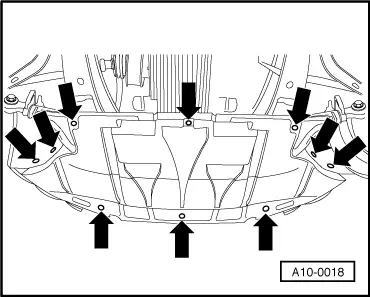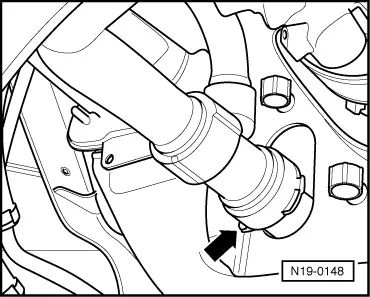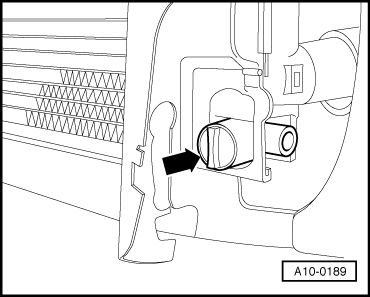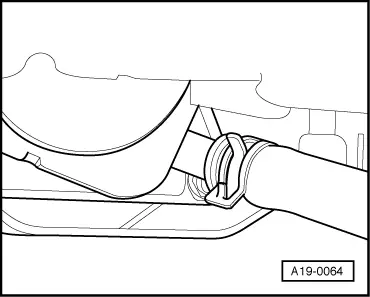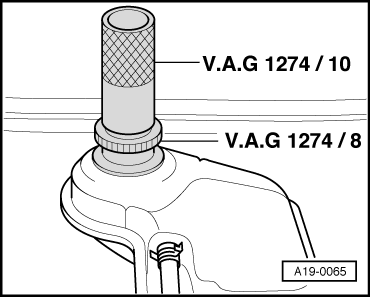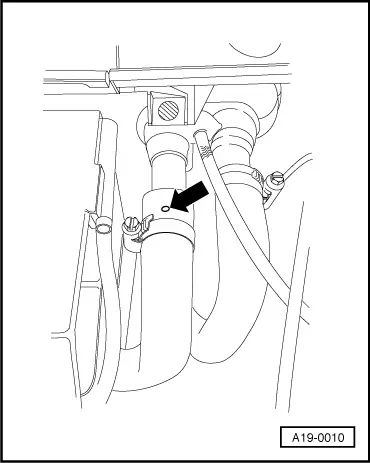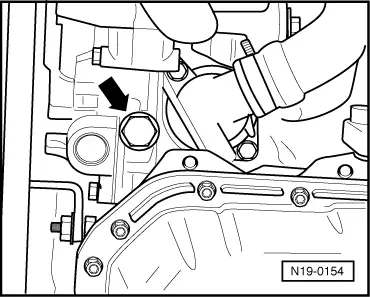-
‒ → Unscrew coolant pump drain plug -arrow-.
Filling
Notes:
-
◆ The cooling system is filled all year round with a mixture of water and coolant additive (combined anti-freeze and corrosion protection agent).
-
◆ Coolant additive G 011 A8 C (green) is used in vehicles up to 06.96.
-
◆ Only coolant additive G 012 A8 D (red) is used in vehicles from 07.96 onwards.
Caution
The two different coolant additives G
-
◆ If the fluid in the expansion tank is brown, this means G 012 A8 D has been mixed with another type of coolant. In this case, flush out the cooling system and put in fresh coolant. To flush the system, fill it with clean water and run the engine for about 2 minutes. This should remove very nearly all of the old coolant.
-
◆ G 011 A8 C and G 012 A8 D (and coolant additives marked "meeting specification TL VW 774 C" or "meeting specification TL VW 774 D") prevent frost and corrosion damage, stop scaling and at the same time raise the boiling point of the coolant. For these reasons the cooling system must be filled all year round with the correct anti-freeze and anti-corrosion additive.
-
◆ Because of its high boiling point, the coolant improves engine reliability under heavy loads, particularly in countries with tropical climates.
-
◆ Anti-freeze protection should be ensured down to about -25 °C (or down to about -35 °C in countries with arctic climate).
-
◆ The coolant concentration must not be reduced by adding water even in warmer seasons and in warmer countries. The anti-freeze ratio must be at least 40 %.
-
◆ If greater anti-freeze protection is required in very cold climates, the concentration of G 011 A8 C or G 012 A8 D can be increased, but only up to 60 % (this gives frost protection down to about -40 °C). If the concentration is increased further, this would reduce anti-freeze protection again and impair cooling effectiveness.
-
◆ If radiator, heat exchanger, cylinder head or cylinder head gasket is replaced, do not reuse old coolant.
Recommended mixture ratios:
|
Anti-freeze protection to
|
Anti-freeze concentration
|
Quantity of
coolant additive 1)
|
Quantity of water1)
|
|
-25 °C
-35 °C
|
40 %
50 %
|
2.4 ltr.
3.0 ltr.
|
3.6 ltr.
3.0 ltr.
|
1) Capacity of cooling system: 6.0 litres (may vary depending upon equipment fitted to vehicle)
-
‒ Install lower coolant hose and secure.
-
‒ Replace seal and install coolant pump drain plug (30 Nm)
Vehicles with small filler cap:
|
